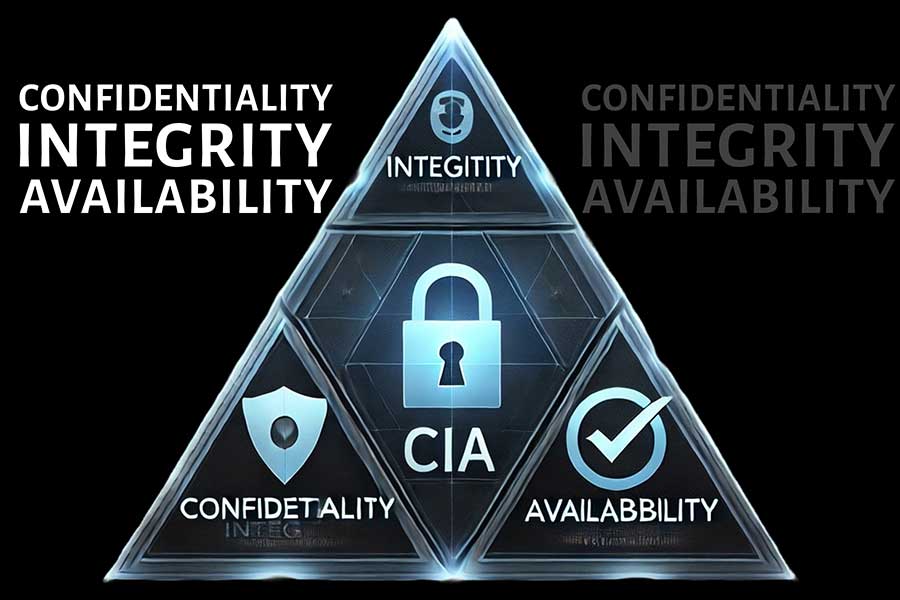The CIA Triad is a fundamental concept in Cybersecurity, representing the three core principles that safeguard sensitive data and systems:
- Confidentiality (C) – Protecting data from unauthorized access.
- Integrity (I) – Ensuring data accuracy and consistency.
- Availability (A) – Guaranteeing reliable access to data when needed.
These three pillars form the backbone of information security, providing a framework for developing robust defence strategies. Let me break down each component and explore its importance, real-world examples, and best practices.
1. Confidentiality: Protecting Sensitive Data
Confidentiality refers to the practice of preventing unauthorized access to sensitive information. It ensures that only authorized individuals or systems have access to specific data, preventing leaks, theft, or unauthorized disclosure.
Key Principles of Confidentiality:
- Access Controls: Using authentication mechanisms like usernames, passwords, biometrics, and multi-factor authentication (MFA).
- Encryption: Protecting data by converting it into unreadable code, ensuring only authorized parties can decrypt it.
- Data Masking and Tokenization: Concealing sensitive data during transmission or processing.
- Least Privilege Principle: Granting users the minimum access necessary to perform their tasks.
Real-World Examples:
- Data Breaches: In 2017, the Equifax breach exposed the personal information of 147 million people due to poor access controls and unpatched vulnerabilities.
- Healthcare Data Privacy: HIPAA regulations enforce strict confidentiality rules to protect data in the healthcare sector.
Best Practices for Ensuring Confidentiality:
- User end-to-end encryption for sensitive communications.
- Implement strong access controls and regularly review permissions.
- Educate employees on phishing attacks and social engineering.
- Enforce data classification policies to manage access levels.
2. Integrity: Ensuring Data Accuracy and Reliability
Integrity ensures that data is accurate, complete, and unaltered from its original state. It prevents unauthorized or accidental modifications and ensures that data remains trustworthy throughout its lifecycle.
Key Principles of Integrity:
- Hashing: Using hash functions (e.g., SHA-256) to create unique fingerprints of data. Any alteration changes the hash value, signalling potential tampering.
- Checksums and Digital Signatures: Verifying the authenticity and integrity of transmitted data.
- Version Control: Keeping records of changes to detect unauthorized modifications.
- Data Validation: Ensuring inputs and outputs meet predefined accuracy standards.
Real-World Examples:
- Website Defacement: Attackers altering website content damages its integrity and reputation.
- Banking Transactions: Financial institutions use hashing and cryptographic methods to prevent tempering with transaction records.
Best Practices for Ensuring Integrity:
- Implement file integrity monitoring (FIM) tools to detect unauthorized changes.
- Use digital signatures to validate documents and messages.
- Perform regular data integrity checks and audits.
- Use immutable backups to prevent data corruption by ransomware attacks.
3. Availability: Ensuring Reliable Access to Data and Systems
Availability guarantees that data and systems are accessible to authorized users when needed. It prevents disruptions caused by hardware failures, cyberattacks, or natural disasters.
Key Principles of Availability:
- Redundancy and Failover: Using backup systems and redundant infrastructure to prevent downtime.
- Disaster Recovery Plan (DRP): Ensuring rapid recovery after security incident or system failure.
- Load Balancing: Distributing network traffic to prevent server overload.
- DDoS Protection: Mitigating Distributed Denial-of-Service (DDoS) attacks that could crash systems.
Real-World Examples
- Amazon Web Services (AWS) Outage: In 2020, an AWS outage disrupted services for companies like Netflix and Disney+, highlighting the importance of availability.
- DDoS Attacks: In 2016, the Dyn attack brought down major websites like Twitter, Reddit, and Spotify due to a large-scale DDoS attack.
Best Practices for Ensuring Availability:
- Use Cloud-based backups and regular data replication.
- Employ uptime monitoring tools to detect and respond to outages.
- Implement service-level agreements (SLAs) to guarantee uptime commitments.
- Use content delivery networks (CDNs) to distribute traffic and reduce latency.
The Interplay of the CIA Triad
While the three principles of the CIA Triad are distinct, they are deeply interconnected. A weakness in one can compromise the others. For instance:
- Availability issues: (e.g., downtime) may prevent authorized access, impacting both integrity and confidentiality.
- Integrity breaches: (e.g., data tampering) can lead to unauthorized access, compromising confidentiality.
- Confidentiality failures (e.g., data leaks) can expose sensitive information, affecting integrity.
Effective cybersecurity strategies require balancing all three principles, as over-prioritizing one could weaken another. For example:
- Excessive confidentiality measures may limit access, affecting availability.
- High availability without strict integrity controls may allow unauthorized modifications.
Challenges in Maintaining the CIA Triad
Despite its simplicity, maintaining the CIA Triad in real-world environments is complex due to:
- Advanced Persistent Threats (APTs): Sophisticated attackers targeting all three pillars.
- Zero-Day Vulnerabilities: Unpatched vulnerabilities affecting integrity and availability.
- Cloud and (IoT) Security: Increased complexity with cloud adoption and Internet of Things (IoT) devices.
- User Errors: Accidental data deletions or incorrect permissions affecting confidentiality and integrity.
The CIA Triad is the cornerstone of cybersecurity, guiding organizations in building robust security frameworks. To protect against modern threats, organizations must:
- Implement layered security controls.
- Regularly conduct risk assessments.
- Enforce security policies aligned with the CIA Triad principles.
In this post, we learnt how prioritizing confidentiality, integrity, and availability, businesses can minimize risks, protect sensitive data, and ensure seamless operations in the increasingly complex digital landscape.
If you are new to Cybersecurity, you may find the article Cybersecurity for Beginners helpful. I also suggest you to read the previous post Common Cybersecurity Myths Debunked which you may find interesting.

